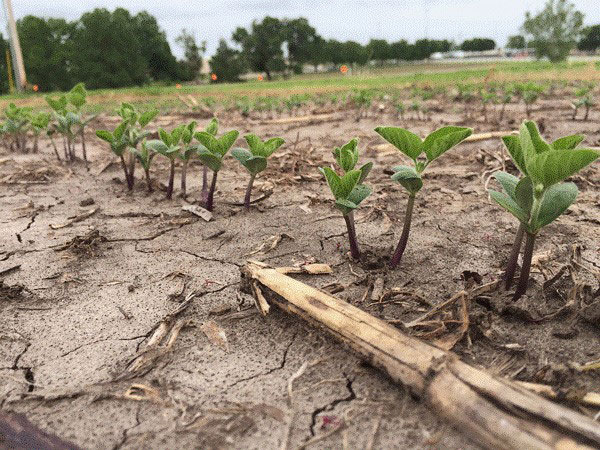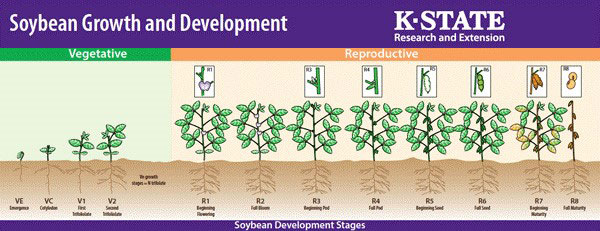Soybean planting in Kansas is progressing but there are still soybean fields to get planted. In the latest USDA Crop Progress and Condition report (June 7, 2020), soybeans planted was at 68% complete, behind 77% last year but ahead of the long-term average of 62%.
Looking back a little to the historical planting dates for our state, in recent decades Kansas producers have been planting soybeans slightly earlier -- at the rate of about one-third day per year (Figure 1). In the past five growing seasons (2015-19, except for 2018), the “50% planting date” mark was achieved at a similar time (first week of June) statewide. Moreover, the same “50% planting date” mark was attained in 1980 as this current growing season, averaging 50% planting progress by June 1. The largest delay experienced in Kansas was in 1982 with 50% achieved close to the end of June, and getting closer in 2019 with 50% achieved after June 9.

Figure 1. Trend in the date at which 50% of planting progress was achieved for soybean from 1980 to 2021 in Kansas (the last four decades of soybean progress in Kansas). Source: USDA-NASS.
In the places where soybean planting has been delayed (or in double crop soybean systems), producers should consider a few key management practices. Planting soybeans in the right soil conditions is essential for establishing an adequate soybean canopy and improving chances to increase yield potential.

Figure 2. Late-planted soybeans (June 10) into adequate soil conditions. Photo by Ignacio A. Ciampitti, K-State Research and Extension.
Maturity group factor: From our ‘planting date x maturity group’ study in 2014, 2015, and 2016, late planting did not clearly result in a yield reduction at the dryland sites, and caused only a minimal yield reduction at the irrigated site. Medium maturity groups (ranging from 3.8 to 4.8) yielded better, depending on the site and growing season evaluated (Figures 3, 4, and 5). More information related to this study can be found in Agronomy eUpdate issue 851: April 22, 2021.
Seeding rate factor: Increasing the seeding rate of late-planted soybeans by 10-20% as compared to the optimal seeding rate can help compensate for the shortened growing conditions. Research information on seeding rate and late planting of soybeans is currently being investigated further, with more updates on this topic in future issues of the Agronomy eUpdate. The same soybean cultivar planted early in the planting window, under normal conditions, will develop nearly 50% more productive nodes than when planted in late June: 19-25 nodes when planted early vs. 13-16 nodes when planted late. For soybean seeding rates and optimum plant populations, see the associated article from eUpdate issue 852: April 29, 2021.
Row spacing factor: Information on late-planted soybeans across multiple row spacing suggests that narrow-rows (e.g. 7” or 15” vs. 30”) can hasten canopy closure, increasing season-long light interception, weed suppression, and potentially improving biomass and final yield. In some cases, the likelihood of a positive yield response to narrow rows increases as the planting is delayed later in the season.
Finally, proper identification of soybean growth stages can make a difference in yield. We have worked with the United Soybean Board and the Kansas Soybean Commission recently to produce a soybean growth and development chart. It can be downloaded at:
https://www.bookstore.ksre.ksu.edu/pubs/MF3339.pdf

More information about key aspects of each growth stage and management practices can be found in that soybean chart.
Ignacio Ciampitti, Farming Systems
ciampitti@ksu.edu
Stu Duncan, Northeast Area Crops and Soils Specialist
sduncan@ksu.edu